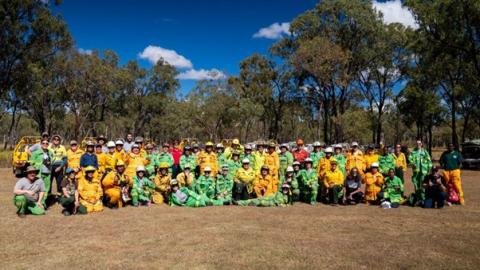


In May, North Queensland became a meeting ground for fire knowledge, cultural exchange and leadership as 37 women and one man from around Australia and the world gathered for the Australian Women in Fire Training Exchange (AUSWTREX) to learn new fire skills, share cultural burning knowledge and develop an international network of leaders in fire.

Image: AUSWTREX attendees on Ewamian Country.
As part of the program, Natural Hazards Research Australia funded a research project to explore how participation impacts First Nations women’s wellbeing (physically, socially, emotionally and spiritually) and memory (ancestral/genetic). While there is growing research on the health and wellbeing benefits of caring for Country, few studies focus specifically on Indigenous women. This project aims to help fill that gap, documenting the impact of First Nations women-led gatherings and cultural fire knowledge exchange on wellbeing and memory.
The National Indigenous Disaster Resilience (NIDR) research program is leading the impact evaluation using a pre-post study methodology. Before the program began, NIDR conducted pre-interviews with seventeen First Nations women selected to attend, gathering a baseline understanding of their experiences with caring for Country (including cultural burning), knowledge sharing and perspectives on wellbeing.
Three NIDR researchers attended the program, including two Indigenous Australian women. One of these researchers was embedded as a participant. Participant observation is a qualitative method that seeks to gain deeper insights into the actions, routines, beliefs and values of a group through actively joining the research participants. By being embedded in the program, their experiences, alongside formal data collection, will be captured, providing a unique perspective as well as additional depth when analysing the data and interpreting the results.
The NIDR team is now preparing to conduct post-program interviews with First Nations women of the AUSWTREX program to understand if and how participating in the program has impacted their wellbeing and memory.
The WTREX program (Women-in-Fire Prescribed Fire Training Exchange) began in 2016 after several female firefighters attended its parent event – the Prescribed Fire Training Exchange (TREX) – and were inspired to create a similar program focused on supporting women in fire. Since its inception, there have been WTREX events across the United States as well as internationally in Canada, South Africa and Portugal.
WTREX aims for women to lead programs that are inclusive of all genders and backgrounds, together to engage in hands-on training, mentoring and networking to become better fire practitioners. In 2022, the Karuk Tribe hosted the first-ever Indigenous WTREX in the remote Klamath Mountains of Northern California. This was a significant event, not only because it was the first Indigenous WTREX, but because it was the first time in 200 years the Karuk Tribe was able to conduct cultural burning on their ancestral lands. Four Indigenous female firefighters from Queensland – Alex Lacey, Chloe Swiney, Evelyn Ivey and Kylee Clubb – attended the Karuk WTREX. Inspired by their experience, Alex, Chloe and Kylee worked to bring the program to Australia.
In May 2025, the second WTREX with an Indigenous focus – and the first of its kind in Australia – was held in Far North Queensland. The 12-day AUSWTREX program was jointly delivered by Queensland Fire Department (QFD), Queensland Parks and Wildlife Services (QPWS), with support from the Australia and New Zealand Council for Fire and Emergency Services (AFAC), WTREX and Fire Networks. It took place across Gimuy and Yirrganydji Country (Cairns), Ewamian Country (Undara Volcanic National Park), Bundarra and Wadjanbarra Country (Tinaroo), and Gunggandji-Mandingalbay Country (Yarrabah). The program received 133 applications, with 38 attendees being selected. A key focus for the AUSWTREX was the role of Indigenous women in fire, hence most attendees were Indigenous women of Australia as well as a handful of Indigenous women from overseas. Some non-Indigenous women also took part in the program and one Indigenous male.
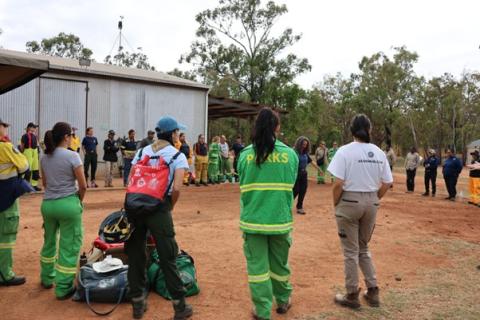
Image: Attendees coming together at the beginning of the AUSWTREX program at the Yarramulla Ranger Base on Ewamian Country.
Attendees first gathered on Gimuy and Yirrganydji Country (Cairns), before travelling to Ewamian Country (Undara Volcanic National Park), where they were welcomed to Country by Uncle Dave Hudson. Highlights on Ewamian Country included a guided walk through the Undara lava tube system with Alex Lacey (Ewamian woman and QPWS Ranger); carrying out prescribed burns in the Undara Volcanic National Park; enjoying a Kup Murri by the campfire; and time to rest and recover at Tallaroo Springs.
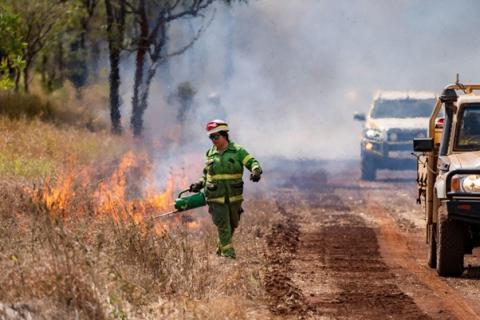
Image: A participant carrying out a prescribed burn on Ewamian Country.
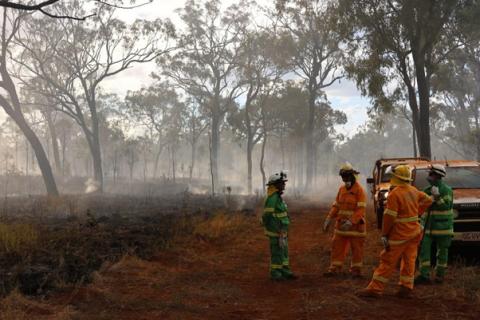
Image: Attendees after a prescribed burn on Ewamian Country.
On Bundarra and Wadjanbarra Country, attendees carried out a cultural burn to protect a sacred and significant women’s site, shared stories in attendee-led sessions and joined in weaving with the women of Jitta Art. On Gunggandji Mandingalbay Yidinji Country, the group was welcomed to Yarrabah by the Gunggandji-Mandingalbay Yidinji (GMY) Rangers and enjoyed a sunset cruise on Mandingalby Yidinji Country.
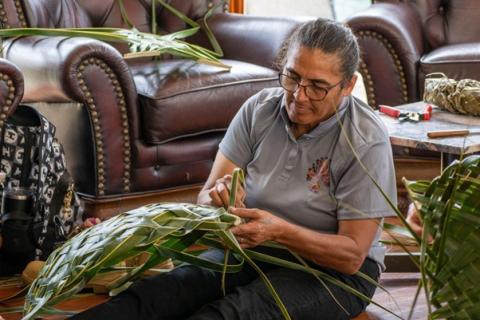
Image: An attendee weaving during the Jitta Arts weaving workshop.
The program’s artwork, The Circle of Flamekeepers, was created by Jedess Hudson, a descendent of the Ewamian and Western Yalanji peoples of North Queensland. The piece represents how each woman is both a student and a teacher and will leave with a connection forged in fire.
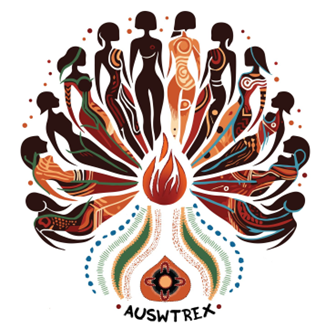
Image: The Circle of Flamekeepers by Jedess Hudson.
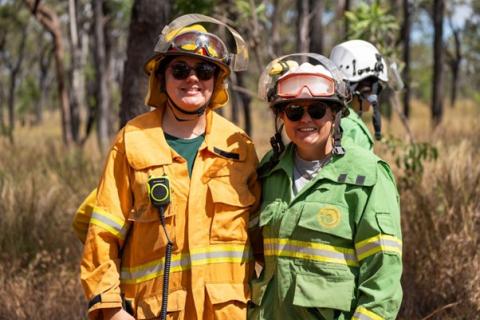
Image: Chloe Swiney (left) and an attendee at a prescribed burn on Ewamian Country.
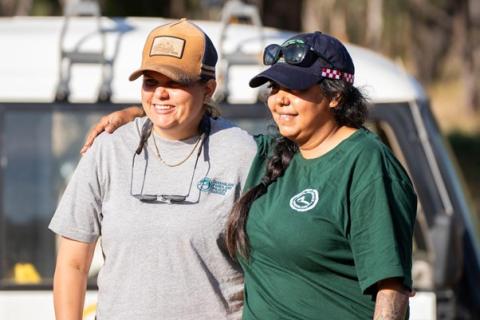
Image: Attendees at the Yarramulla Ranger Base on Ewamian Country.
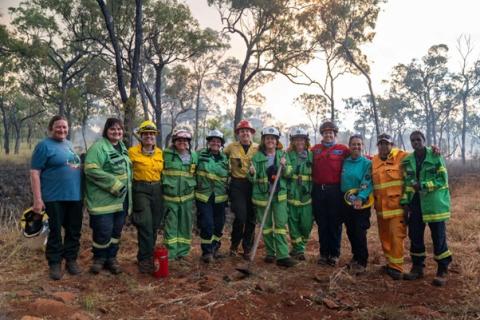
Image: Attendees after a prescribed burn on Ewamian Country.
Throughout the program, it was evident that connections, knowledge and skills were built and shared on and off the fire ground, impacting the women in different ways. NIDR is now working to translate the impacts of the AUSWTREX program into an academic paper and research report, which will be released in early 2026.